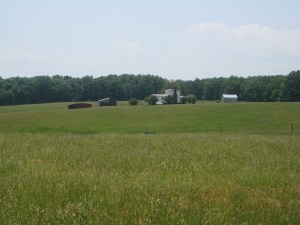The Fight for the Ogg Farm at Trevilian Station

This past weekend, my wife and I had the opportunity to spend time with family at Lake Anna. On Friday morning, we went out to breakfast in Louisa with my wonderful brother and sister-in-law. Driving back to the house, we passed through part of the Trevilian Station battlefield. Much to my surprise, there were two gentleman who had pulled over to read the “First Contact” sign located on State Route 669 north of Louisa. Thinking back, it was one of the very few times that I had seen others out on the driving tour.
Typically when I have visited, I’m the only one there. I have never run into anyone at the Civil War Trails markers located throughout the battlefield. As I thought about it more, something else struck me. It seems that the fighting which occurred on June 11, highlighted by Brig. Gen. George Custer’s desperate fight below the Gordonsville Road, has overshadowed the second day’s action west of Trevilian Station at the Ogg Farm. Following the war, a member of the 6th Pennsylvania Cavalry wrote “the fighting on the 12th, was, if possible, more desperate than the day previous.”
In a bid to break up the enemy supply lines and distract from his own movement from Cold Harbor to Petersburg, Lt. Gen. Ulysses S. Grant dispatched Maj. Gen. Philip Sheridan and two cavalry divisions to central Virginia in early June, 1864. On June 11, Sheridan encountered Maj. Gens. Wade Hampton and Fitzhugh Lee west of Louisa Court House around Trevilian Station.
After trading blows with Sheridan throughout the day, Hampton withdrew to a new position west of the rail stop on the Gordonsville Road. He placed his troopers on property owned by the Ogg family. Brigadier General Matthew Butler’s South Carolinians stood on the left. Pierce M.B. Young’s brigade, under the temporary command of Col. Gilbert Wright held the center. Brigadier General Thomas Rosser’s Laurel Brigade was placed on the right. Rosser had been wounded earlier in the battle and his Virginians were led by Col. Richard Dulany. In order to improve coordination with Lee, Hampton temporarily turned his division over to Butler. Col. Benjamin Rutledge of the 4th South Carolina Cavalry assumed command of his brigade.
“The line formed an obtuse angle on the railroad embankment and extended off to the right with an open field in front, and to the left along the embankment” Butler wrote. “Beginning at the railroad, I had thrown up temporary breastworks of fence-rails and such materials as were available.”
Early on June 12, Maj. Sheridan ordered Brig. Gen. David Gregg’s division to resume destruction of the Virginia Central Railroad. This work continued for the next several hours with no hindrance from the Southerners. In need of information on Confederate whereabouts, early that afternoon Sheridan dispatched Brig. Gen. Alfred Torbert’s division, supported by Brig. Gen. Henry Davies’ brigade toward Gordonsville.
Custer’s shot up Wolverines led Torbert’s advance. Not long after setting out, Custer encountered the Confederates. Still smarting from the previous day’s drubbing, Custer did not launch a full scale attack and was content to probe Hampton’s line.
Deploying on Custer’s right was Brig. Gen. Wesley’s Merritt’s Reserve Brigade. His troopers “went in on an open field…and attacked the enemy’s left flank vigorously”, Merritt recalled. “It was slow work, however, and as the enemy was not pressed on the left he concentrated his force on the brigade…still both officers and men stood up to their work, doing manfully all that their former prowess would lead the most sanguine to expect.”
Butler’s men held firm in the face of Merritt’s attacks. This forced Merritt to send for reinforcements from Col. Thomas Devin’s brigade. Devin immediately dispatched the Fourth and Sixth New York Cavalry to aid his comrade. Merritt also deployed Battery D, 2nd U.S. Artillery under Lt. Edward Williston. “Right gallantly did the battery come up in the midst of a heavy musketry fire”, Merritt wrote. “Planting three guns of the battery…Lieutenant Williston moved one of his brass 12-pounders onto the skirmish line…where he remained with his gun…dealing death and destruction in their ranks with double loads of canister.” Williston would later receive a Medal of Honor for his actions that day.
Despite Merritt’s best efforts, he could not crack the enemy position. Emboldened by Butler’s defense and reinforced by Lee’s division, Hampton decided to launch a flank attack. The Confederate cavalryman directed Lee to deploy Brig. Gen. Lunsford Lomax on Merritt’s right. Late in the day, Lomax sent his men crashing into the Union line. “For a short time after sunset the fighting was fierce” wrote a trooper in the 6th New York, “their…numbers giving us volley after volley when a heavy movement on our right and an enfilading fire from one of their batteries caused us to fall back.”
Lomax’s assault forced Torbert’s division to fall back and eventually break off the engagement. It ultimately proved to be the final phase of the battle. Two days of hard fighting convinced Sheridan that further operations would be futile. The next morning, he abandoned Trevilian Station and began the long march to rejoin the Army of the Potomac.
3 Responses to The Fight for the Ogg Farm at Trevilian Station